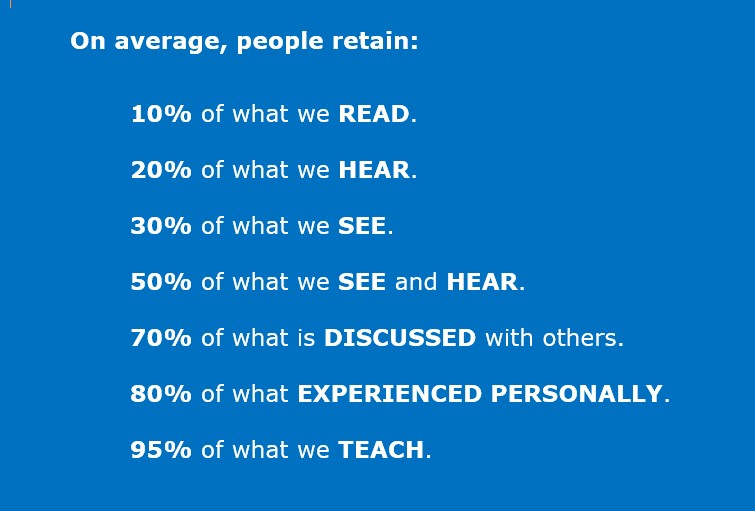The learning retention statistics—10% of what we read, 20% of what we hear, and so on—align well with biblical principles of how followers of Christ are to learn and grow. Jesus’ teaching methods in the New Testament reflect a profound understanding of human nature and learning. By using parables, discussions, personal experiences, and even encouraging His disciples to teach others, Jesus demonstrated how we are called to internalize His Word and grow in faith.
In this article, we’ll explore these retention percentages, supported by both modern educational theory and biblical truths, showing how God’s design for learning has been embedded in Scripture all along.
The Source of the 10-20-30 Rule: Edgar Dale’s “Cone of Experience”
While these specific percentages are widely shared in educational contexts, they can also be seen through a biblical lens. Edgar Dale’s “Cone of Experience,” developed in 1946, highlighted how learning moves from abstract to concrete as we engage more deeply with the material. Though Dale did not include retention rates in his model, the hierarchy of passive to active learning is strikingly similar to the way Jesus taught His disciples.
Biblical Perspective on Dale’s Cone of Experience
Dale’s model emphasizes that learning becomes more effective as we move from passive reception to active engagement. This mirrors Jesus’ method of teaching—He would often start by speaking to the crowds (passive hearing) and then move to deeper discussions with His disciples (active participation). Jesus consistently encouraged His followers to apply His teachings, creating a path from hearing the Word to experiencing and living it out.
“But be doers of the word, and not hearers only, deceiving yourselves.” – James 1:22 (ESV)
10% Retention from Reading
It’s said that we retain only 10% of what we read. While reading Scripture is crucial for believers, the Bible emphasizes that reading alone is not enough. Faith comes from hearing and doing the Word of God. Jesus frequently referenced the Scriptures and encouraged His followers to go beyond merely reading; He expected them to act upon what they learned.
The Importance of Reading Scripture
Reading is the foundation of spiritual growth, as the Word of God is the source of truth. In 2 Timothy 3:16-17, Paul writes that “All Scripture is breathed out by God and profitable for teaching, for reproof, for correction, and for training in righteousness.” Reading God’s Word gives us the knowledge we need, but true understanding and retention come through deeper engagement with what we’ve read.
“Blessed is the one who reads aloud the words of this prophecy, and blessed are those who hear, and who keep what is written in it, for the time is near.” – Revelation 1:3 (ESV)
20% Retention from Hearing
People retain 20% of what they hear, such as sermons, podcasts, or teachings. The Bible emphasizes the importance of hearing the Word of God. Paul wrote in Romans 10:17, “So faith comes from hearing, and hearing through the word of Christ.” However, the Bible also encourages believers not to be passive listeners, but active hearers who apply what they hear.
Jesus’ Emphasis on Listening
Jesus frequently taught the crowds and used phrases like “He who has ears to hear, let him hear” (Matthew 11:15). Hearing was central to His teaching ministry, but He made it clear that listening alone was not enough. Hearing the Word must be combined with obedience and faith.
“Everyone then who hears these words of mine and does them will be like a wise man who built his house on the rock.” – Matthew 7:24 (ESV)
30% Retention from What We See
Research suggests that people retain around 30% of what they see, which can include visual examples, miracles, and actions. Throughout the Gospels, Jesus used visual examples and parables to teach His disciples.
Jesus’ Use of Visual Learning
Jesus often pointed to the world around Him to illustrate spiritual truths. He used parables and everyday objects—mustard seeds, fig trees, or a lamp on a stand—as visual aids to teach deeper lessons about the Kingdom of God. His miracles were also powerful visual representations of His authority and message.
“He told them many things in parables, saying: ‘A sower went out to sow…’” – Matthew 13:3 (ESV)
Seeing Jesus perform miracles, such as healing the sick and raising the dead, deeply impacted the disciples and the crowds who followed Him. These experiences served as living examples of God’s power and truth, reinforcing what they had heard Him teach.
50% Retention from What We See and Hear
Retention increases to 50% when we both see and hear information, such as in the teaching of parables accompanied by miracles. Jesus used this method frequently, combining His words with actions to demonstrate the reality of His teachings.
The Power of Seeing and Hearing in Jesus’ Ministry
One of the most powerful examples of this is when Jesus healed the paralytic. In Mark 2, Jesus not only said to the man, “Your sins are forgiven,” but also told him, “Get up, take your mat and walk.” Those present saw and heard the authority of Jesus in action, which left a lasting impression.
“But that you may know that the Son of Man has authority on earth to forgive sins…He said to the paralytic, ‘I say to you, rise, pick up your bed, and go home.’” – Mark 2:10-11 (ESV)
70% Retention from Discussions
Discussing what we learn significantly increases retention, as seen when Jesus often gathered His disciples to explain deeper truths privately. After teaching the crowds, He would sit with His disciples and answer their questions, engaging in deeper conversations to help them fully understand.
Jesus’ Use of Discussion to Solidify Learning
In Matthew 13, after teaching the parable of the sower, His disciples asked Him, “Why do you speak to the people in parables?” Jesus used this discussion as an opportunity to explain not only the meaning of the parables but also the mysteries of the Kingdom of Heaven. These discussions helped His disciples better retain and understand His teachings.
“Then the disciples came and said to him, ‘Why do you speak to them in parables?’ And he answered them, ‘To you it has been given to know the secrets of the kingdom of heaven…’” – Matthew 13:10-11 (ESV)
80% Retention from Personal Experience
Experiential learning results in around 80% retention, and Jesus frequently allowed His disciples to learn through experience. He didn’t just teach them about ministry; He sent them out to do it. In Luke 10, Jesus sent out 72 of His followers to preach the gospel, heal the sick, and cast out demons.
Learning by Doing in Jesus’ Ministry
When the disciples returned from their missions, they were overjoyed by the power of their experience. Jesus understood that by doing the work of the Kingdom themselves, they would understand and retain the lessons far more deeply than if they had simply heard Him speak about it.
“The seventy-two returned with joy and said, ‘Lord, even the demons submit to us in your name.’” – Luke 10:17 (NIV)
95% Retention from Teaching Others
Finally, teaching others is the most effective way to retain information, with a retention rate of 95%. This principle is deeply biblical. Jesus often taught His disciples so that they, in turn, could go out and teach others. The Great Commission in Matthew 28:19-20 commands all believers to go and teach others what Jesus had taught them.
Jesus’ Call to Teach
Jesus empowered His disciples to become teachers themselves. After three years of walking with Him, listening to His teachings, and experiencing His miracles, Jesus told them, “Go therefore and make disciples of all nations… teaching them to observe all that I have commanded you” (Matthew 28:19-20). By teaching others, the disciples not only spread the gospel but also solidified their own understanding of Christ’s teachings.
“And what you have heard from me in the presence of many witnesses entrust to faithful men, who will be able to teach others also.” – 2 Timothy 2:2 (ESV)
Conclusion: Maximizing Retention Through Biblical Principles
The retention hierarchy, both in modern educational theory and as seen in Scripture, demonstrates that active learning—such as discussing, doing, and teaching—is far more effective than passive learning methods like reading or listening. Jesus modeled this method of teaching in His interactions with His disciples, using visuals, discussions, experiences, and the call to teach others.
By following Jesus’ example of active engagement with the Word, we can grow in our understanding and retention of biblical truths, ultimately becoming better equipped to live out and share our faith.
Remember on average, people retain: 10% of what we READ, 20% of what we HEAR, 30% of what we SEE, 50% of what we SEE and HEAR, 70% of what is DISCUSSED with others, 80% of what EXPERIENCED PERSONALLY, 95% of what we TEACH.
References
- The Holy Bible, English Standard Version.
- Medina, John. Brain Rules. Pear Press, 2014.
- Mayer, Richard E. “Multimedia Learning: Are We Asking the Right Questions?” Psychological Science in the Public Interest, vol. 8, no. 3, 2019.
- Paivio, Allan. “Dual Coding Theory: Retrospect and Current Status.” Canadian Journal of Psychology, vol. 45, 1991, pp. 255-287.
- Kolb, David A. Experiential Learning: Experience as the Source of Learning and Development. Prentice-Hall, 1984.





